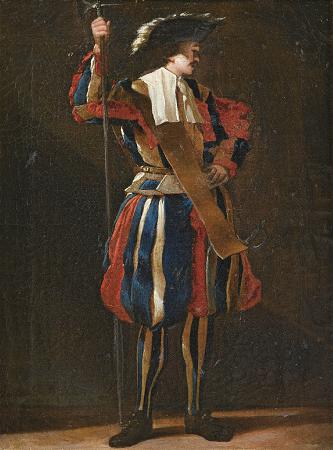Liberty Leading People (1830). Oil on canvas. 260 x 325. Liberty Leading the People is a painting by Eugène Delacroix commemorating the July Revolution of 1830, which toppled King Charles X of France. A woman of the people with a Phrygian cap personifying the concept of Liberty leads a varied group of people forward over a barricade and the bodies of the fallen, holding the flag of the French Revolution-the tricolour, which again became France's national flag after these events-in one hand and brandishing a bayonetted musket with the other. The figure of Liberty is also viewed as a symbol of France and the French Republic known as Marianne. By the time Delacroix painted Liberty Leading the People, he was already the acknowledged leader of the Romantic school in French painting. Delacroix, who was born as the Age of Enlightenment was giving way to the ideas and style of romanticism, rejected the emphasis on precise drawing that characterised the academic art of his time, and instead gave a new prominence to freely brushed colour. Delacroix painted his work in the autumn of 1830. In a letter to his brother dated 21 October, he wrote: My bad mood is vanishing thanks to hard work. I've embarked on a modern subject, a barricade. And if I haven't fought for my country at least I'll paint for her. The painting was first exhibited at the official Salon of 1831. Delacroix depicted Liberty as both an allegorical goddess-figure and a robust woman of the people. The mound of corpses acts as a kind of pedestal from which Liberty strides, barefoot and bare-breasted, out of the canvas and into the space of the viewer. The Phrygian cap she wears had come to symbolize liberty during the first French Revolution, of 1789. The painting has been seen as a marker to the end of the Age of Enlightenment, as many scholars see the end of the French Revolution as the start of the romantic era. The fighters are from a mixture of social classes, ranging from the bourgeoisie represented by the young man in a top hat, a student from the prestigious École Polytechnique wearing the traditional bicorne, to the revolutionary urban worker, as exemplified by the boy holding pistols. What they have in common is the fierceness and determination in their eyes. Aside from the flag held by Liberty, a second, minute tricolore can be discerned in the distance flying from the towers of Notre Dame. The identity of the man in the top hat has been widely debated. The suggestion that it was a self-portrait by Delacroix has been discounted by modern art historians. In the late 19th century, it was suggested the model was the theatre director Étienne Arago; others have suggested the future curator of the Louvre, Frédéric Villot; but there is no firm consensus on this point. Several of the figures are probably borrowed from a print by popular artist Nicolas Charlet, a prolific illustrator who Delacroix believed captured, more than anyone else, the peculiar energy of the Parisians. The French government bought the painting in 1831 for 3,000 francs with the intention of displaying it in the throne room of the Palais du Luxembourg as a reminder to the citizen-king Louis-Philippe of the July Revolution, through which he had come to power. This plan did not come to fruition and the canvas hung in the palace's museum gallery for a few months, before being removed due to its inflammatory political message. After the June Rebellion of 1832, it was returned to the artist. According to Albert Boime, Champfleury wrote in August 1848 that it had been hidden in an attic for being too revolutionary. Although Louis-Philippe's Ministry of the Interior initially acquired it as a gesture to the Left, after the uprising at the funeral of Lamarque in June 1832 it was never again openly displayed for fear of setting a bad example. Delacroix was permitted to send the painting to his aunt Félicité for safekeeping. It was exhibited briefly in 1848, after the Republic was restored in the revolution of that year, and then in the Salon of 1855. In 1874, the painting entered the collection of Palais du Louvre in Paris. In 1974-75, the work was the featured work in an exhibit organized by the French government, the Metropolitan Museum of Art in New York and the Detroit Institute of Arts as a Bicentennial gift to the people of the United States. The exhibit, entitled French Painting 1774-1830: The Age of Revolution, marked a rare display of the Delacroix painting, and many of the other 148 works, outside France. The exhibit was first shown at the Grand Palais from 16 November 1974 to 3 February 1975. It moved to Detroit from 5 March to 4 May 1975, then New York from 12 June to 7 September 1975. In 1999, it was flown on board an Airbus Beluga from Paris to Tokyo via Bahrain and Calcutta in about 20 hours.
more...





